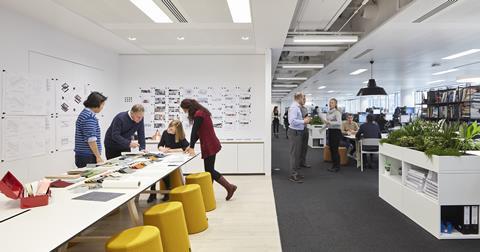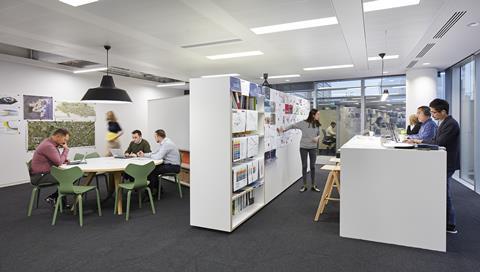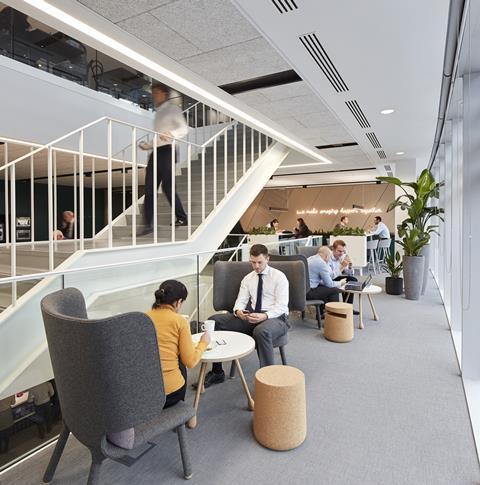Office occupiers and their employees are demanding space that supports new, more efficient ways of working, with a range of environments within a building tailored to different activities. What are the implications for workplace design and fit-out? Martin Kellett and Nicola Gillen of Aecom explain

01 / Introduction
Although Brexit continues to cast its shadow over the longer-term future of the real estate sector, trends in commercial office fit-out keep evolving. Developers and clients want to get the most out of space. Workers want a more flexible way of doing things, with offices that support collaboration and allow them to share information wherever they are – whether that is inside or indeed outside the building.
This means that concepts of “agile” or “activity-based” working – where an office provides a range of environments tailored to different kinds of work – are becoming a reality. In these spaces, formal and informal meeting rooms are mixed with quieter areas. Amenities such as cafes allow a diverse workforce to meet and socialise. Offices are becoming communities, with co-location of different teams or even companies driving new ideas and collaboration.
Aecom produced its first cost model on activity-based working in 2014. Since then the idea has gathered momentum, with the concept becoming more mainstream and becoming the starting point from which workplace strategies and office layouts are generated.
02 / Market transition from category A to activity-based space
The Q2 real estate data for 2017 demonstrates how agile, activity-based working is becoming more mainstream in the office market. Cushman & Wakefield reports that office-as-a-service (OaaS) providers accounted for the largest share of space leased in central London in the quarter at 28%, proof that we are observing a sea change in the way we work. Overall, OaaS was second only to technology, media and telecommunications in terms of space secured in the quarter.
While corporate clients in other sectors are more cautious than those in the OaaS sector when it comes to expansion – a result, probably, of the ongoing post-EU referendum uncertainty – many are adopting activity-based working principles to drive efficiency and productivity.
Corporates and central government are consolidating large, fragmented estates into fewer locations, leading to lower operational costs, reinforced identity and greater collaboration within the business.
Some major companies also are seeing benefits of extracting teams from their own corporate environments. A significant number of corporate occupiers have hived off teams and located them in a co-working space such as WeWork. This is particularly prevalent with innovation teams who are seeking to distance themselves from corporate bureaucracy.
The move to consolidate dispersed real estate portfolios has led to an increase of “grey space” on the market, as corporations vacate and move to large hubs.
In Q2, 9.4 million ft2 of this secondhand office space was available for rent in central London, perhaps masking the shortfall of new space being released. As these spaces free up, landlords kick off projects to bring them back to Category A (basic landlord fit-out) in preparation for marketing. Some are questioning the wisdom of this traditional Category A installation, instead taking the opportunity to make their space more contemporary and marketable.
This is hardly a controversial move. Back in the mid-1980s and 1990s the norm was to not install Category A fit-out at all. But as the market became more heated, agents started to provide Category A as a differentiator and specifications were stepped up to give tenants a sense of pride in their surroundings.
While this was understandable when the market was bullish, tenants now have a different agenda. They want more say in their environment and more social space. They have greater sustainability expectations and they want to attract the right staff, who are also more aware of these issues. They want activity-based working, or something like it.

03 / The shape of things to come
Developers are becoming more aligned with the requirements of an activity-based workplace and the infrastructure required to maximise its potential. With the wisdom of Category A under debate and a growing expectation for activity-based workplaces among clients and workforces, there are implications for landlords and tenants to consider.
- Should new and refurbished office spaces be offered as mostly shell and core, with a marketing suite to show options for finishes, systems and specifications? Shell and core buildings themselves are incorporating additional features to complement the agile ethos, for example using reception areas to create public spaces. Derwent London has rolled this out at the White Chapel ĐÇżŐ´«Ă˝, with the reception being specifically designed as a space open to the public.
- There may also be a shift to branded offices, offering a distinct base product for specific market sectors. Different tenant sectors require a different look and feel, so there will be less demand for standard Category A fit-out.
Activity-based working: the new normal
From being almost a wholly economics-driven concept in the 1990s – seeking principally to eliminate overcapacity, reduce space requirements and cut real estate costs – the idea of activity-based working has broadened as it has grown in popularity.
As millennials come of age, the flexibility and sense of community that activity-based working provides has become an expectation for the workplace, rather than a privilege for certain teams or tiers of management.
Initially, the lack of activity-based working schemes meant that workplace strategists struggled to demonstrate its benefits with hard data. This was compounded by the fact that workplace measurement was often not included in capital budgets, making it difficult for clients to source funding for post-occupancy studies. In addition, the benefits of activity-based working are easy to measure from a real estate perspective but harder to quantify in terms of people and productivity.
As more projects have been rolled out, driven initially by the economic advantages of being able to fit more people into a smaller space, occupiers can now see the positive effects for themselves. This is complemented by positive user feedback that demonstrates the wider, non-financial benefits of a forward-thinking workplace strategy.
Clients should still proceed with caution in some areas. Research by workplace performance consultant Leesman published in February 2017 found that activity-based working has been shown to be less effective for teams undertaking less complex tasks that do not require a high level of mobility in an office environment.
Even in environments where activity-based working is appropriate, employee inertia may prevent increases in productivity. Employees should be educated in the required behaviours and resultant benefits from agile working, backed up with solid processes and management leadership.
A building alone will not change behaviour or drive productivity. Information technology is a critical enabler of activity-based working, as is change management. If people are dropped into a new environment with no training, they will behave as they did before. Preparing people for the space is just as important as preparing the space for the people.
Francesca Jack, a director of Aecom’s workplace strategy team, agrees: “Having a robust and flexible change management plan with a carefully thought-out programme of engagement activities can really help capture the hearts and minds of employees and therefore help an employee adopt new ways of working and new behaviours more quickly, building organisational resilience throughout the project life cycle.”
Change management and employee engagement will be critical for the successful transition to these new ways of working. Aecom believes the future will see real estate strategy more closely aligned with corporate HR functions, such is the importance of the working environment in terms of attraction and retention of staff.
04 / Case study: Aecom at Aldgate Tower
Aecom’s new UK headquarters, at Aldgate Tower in east London (from which the images on these pages are taken), is an example of activity-based working in action. The company used the move from its old base in the West End to rethink ideas of what a head office could be and how to energise its workers.
The design strategy designated 50% of the space as collaborative, to foster interaction and informal meetings. There are touchdown and break-out spaces, plus quiet working areas. Internal accommodation stairs complement the usual lifts and escape stairs, encouraging networking. Agile working protocols mean desks are shared by a team, with 25% of them “sit-stand”. Unified communications have replaced desk phones and terminals with laptops, smartphones and pervasive wi-fi.
Extensive research, employee engagement and training accompanied the move, which has resulted in the highest utilisation rate of all Aecom’s UK offices. Staff attrition has more than halved in the year since Aecom moved in. Feedback from teams throughout the building has been positive, with employees noting that the new workplace has increased productivity and collaboration.

05 / Design
Audiovisual installations
Technology is an important driver of activity-based working. Without an IT infrastructure that enables people to share information and communicate wherever they are in the building, new ways of working may struggle to gain traction.Getting the audiovisual (AV) installation right is critical, as it is these tools that allow collaboration in both formal and informal settings – indeed, some AV solutions such as Steelcase’s Mediascape, or Ahrend’s Balance system, have almost become default work settings. Minor outages in support systems such as wi-fi or room booking systems may lead to a loss of faith in the workplace strategy. Networks and equipment must be robust.
Audiovisual is becoming one of the largest packages in terms of the percentage of overall cost of measured works and is certainly an important critical path consideration. Greater use of larger screens has led to the adjustment of plasterboard specifications to include pattressing, with up to 18mm of plywood being incorporated into the partition.
This, together with the requirement for data, power and containment, means the AV package is a key part of the sequence at the design stage. AV equipment is also getting less expensive, replacing some of the more cumbersome AV solutions previously seen as mission-critical, such as telepresence and early video conferencing. Similar results can now be achieved at a much lower cost.
Clients are becoming more pragmatic in the selection and functionality of AV systems, allowing cost-effective solutions for everyday small collaborative areas. Cost drivers in this area include the size and specification of screens, wireless connections, functionality (such as Barco ClickShare) and bespoke integration with joinery.
And because the incorporation of AV allows office workers to collaborate more easily, companies can reduce the number of fixed workstations installed and move the space towards a better balance between collaborative and individual workspaces.
Integrated network systems
Another recent trend is a move towards integrated network systems (INS), which put all systems on one common data network. INS enables data from all building systems to be viewed at the same time and analytics to be carried out in one environment. This “single pane of glass” makes life easier for building managers, while helping them improve building performance through analysing trends and usage. Systems can be fine tuned to optimise sustainability and efficiency.
INS requires the building’s data network to be installed and commissioned much earlier in the fit-out programme. It
















